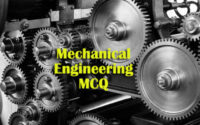Question Bank on Diploma Mechanical Engineering
Interested users can download the Question Bank on Diploma Mechanical Engineering from the links enclosed below. Download the Last 5 Years Question Bank on Diploma Mechanical Engineering Solved along with the Answers of each question.

This Question Bank on Diploma Mechanical Engineering may vary from the Actual paper. Use the Question Bank on Diploma Mechanical Engineering as a reference for the exam preparation. Check the Question Bank on Diploma Mechanical Engineering from this page.
At the bottom of this page, you will find ‘Click here links’ for downloading the Question Bank on Diploma Mechanical Engineering. Click on the required link & download your related Question Bank on Diploma Mechanical Engineering to make as a reference for your scheduled preparation.
Diploma Mechanical Engineering Question Bank Paper
1. In an ideal Brayton cycle, the heat is added at
(a) constant volume
(b) constant pressure
(c) constant temperature
(d) constant entropy
2. The function of an inter cooler in a gas turbine plant is
(a) to cool the exhaust gas from the turbine
(b) to cool compressed air from compressor
(c) to cool atmospheric air before inlet to compressor
(d) to cool the compressed air in between the stages
3. COP of a Carnot refrigeration cycle is greater than
(a) vapour compression cycle
(b) reversed Brayton cycle
(c) vapour absorption cycle
(d) all of these
4. Which of the variable controls the physical properties of a perfect gas?
(a) Pressure
(b) Temperature
(c) volume
(d) all of these
5. Boyle’s law is applicable to gases under
(a) only Small range of pressure
(b) high range of pressure
(c) steady range of pressure
(d) all range of pressure
6. Which of the following can be regarded as gas so that gas laws could be applicable, within the commonly encountered temperature limits?
(a) O2, N2, steam, CO2
(b) O2, N2, water vapour
(c) SO2, NH3, CO2, moisture
(d) O2, N2, H2, air
7. Temperature of a gas is produced due to
(a) Its heating value
(b) Kinetic energy of molecules
(c) Repulsion of molecules
(d) Attraction of molecules
8. 1 bar in SI units is
(a) 1×105 Pa
(b) 100 kPa
(c) 0.987 atm
(d) All of these
9. Which of the following is an extensive property?
(a) Volume
(b) Temperature
(c) Pressure
(d) Density
10. When the rate of evaporation of water is zero, the relative humidity of the air is
(a) 0%
(b) 100%
(c) 50%
(d) Unpredictable
11. When H1=total heat of air entering the coil (heating or cooling), H2= total heat of the air leaving the coil (heating or cooling), H3= total heat of air at the end of the process (humidification or dehumidification), then the sensible heat factor (H2-H1)/(H3-H1) represents the process of
(a) Cooling and humidification
(b) Cooling and dehumidification
(c) Heating and humidification
(d) Heating and dehumidification
12. The dew point temperature is less than the wet bulb temperature for
(a) Standard air
(b) Unsaturated air
(c) Both saturated and unsaturated air
(d) None of these
13. For charging a tank
(a) Enthalpy is converted to work done
(b) Work done is converted to enthalpy
(c) Enthalpy is converted to internal energy
(d) Internal energy is converted to work done
14. The first law of thermodynamics deals with
(a) heat and work
(b) quality of energy
(c) balance of quantity of energy
(d) measurement of energy transfer
15. The perpetual motion machine of the first kind is impossible according to the
(a) zeroth law of thermodynamics
(b) first law of thermodynamics
(c) second law of thermodynamic
(d) third law of thermodynamics
16. The latent heat of vaporization with increase in pressure of water
(a) Increases
(b) remains constant
(c) decreases
(d) none of these
17. In an isothermal process
(a) temperature increases gradually
(b) volume remains constant
(c) change in internal energy is zero
(d) enthalpy change is maximum
18. In a reversible adiabatic process, the work transfer is equal to
(a) decrease in enthalpy
(b) decrease in internal energy
(c) heat transfer
(d) the product of pressure and change in volume
19. A control mass gives out 10 kJ of energy in the form of heat transfer at 5000C. Find the change in availability of the control mass
(a) -4.14 kJ
(b) -5.14 kJ
(c) -6.14 kJ
(d) -7.14 kJ
20. In turbofan engine, fan is used
(a) To compress the inlet air more efficiently
(b) To increase the total thrust of the engine
(c) Both (a) & (b)
(d) None of these
21. Gas turbines are suitable for aircraft propulsion because
(a) Gas turbines are light weight
(b) Gas turbines are compact in size
(c) Gas turbines have a high power to weight ratio
(d) All of these
22. The volatile petroleum fuels of high octane number, pre-ignition is reduced at ________ mixture
(a) Very rich
(b) Very lean
(c) Equal
(d) None of these
23. The pressure of supercharger used is
(a) 1 to 1.3 bar
(b) 1.2 to 1.4 bar
(c) 1.3 to 1.5 bar
(d) 1.5 to 1.8 bar
24. The following factors affect the process of carburetion
(a) Engine speed
(b) The temperature of incoming air
(c) The volatility of fuel
(d) All of these
25. The difference of fuel level of tip of main nozzle and fuel level in float chamber of a simple carburetor is called
(a) Nozzle lip
(b) Nozzle dip
(c) Throttle lip
(d) Throttle dip
More Question Set on Mechanical Engineering Diploma MCQs from Various Exam
| Model Question | Old Question |
| Sample Papers | Mock Test |
| Practice Set | Question Bank |
| Important Questions | Test Papers |
| Typical Questions | Selected Questions |
26. Aero planes employ following type of compressors
(a) Radial flow
(b) Axial flow
(c) Centrifugal
(d) Combined of above
27. Internal energy of a perfect gas depends on
(a) temperature, specific heat and enthalpy
(b) temperature, specific heat and entropy
(c) temperature, specific heat and pressure
(d) temperature only
28. A refrigerator and heat pump operates between same temperature limits. If the COP of the refrigerator is 4, what is the COP of heat pump?
(a) 3
(b) 5
(c) 4
(d) 3.4
29. It is impossible to construct an engine which while operating in a cycle, produces no other effect except to extract the heat from a single-temperature reservoir and do equivalent amount of work.
(a) It refers to Clausius statement.
(b) It refers to Kelvin–Planck’s statement.
(c) It refers to Carnot’s theorem.
(d) It refers to Clausius’s theorem.
30. The degradation of energy is responsible for
(a) entropy generation within the system
(b) decrease of entropy within the system
(c) maximum work done by the system
(d) none of these
31. Bernoulli’s equation cannot be applied when the flow is
(a) Rotational
(b) Turbulent
(c) unsteady
(d) all of these
32. Streamline and equipotential lines in a flow field
(a) are parallel to each other
(b) are identical to each other
(c) are perpendicular to each other
(d) intersect at acute angles
33. A flow is called super-sonic if the
(a) velocity of flow is very high
(b) discharge is difficult to measure
(c) Mach number is between 1 and 5
(d) Mach number is less than 1
34. The dynamic viscosity of a liquid is 1.2 × 10-4 Ns/m2, whereas, the density is 600 kg/m3. The kinematic viscosity in m2/s is
(a) 72 × 10-3
(b) 20 × 10-8
(c) 7.2 × 103
(d) 70 × 106
35. The anti-knock property of the fuel depends on its
(a) Self-ignition temperature
(b) Molecular structure
(c) Chemical composition
(d) All of these
36. Newton’s law of viscosity states that
(a) the shear stress applied to the fluid is directly proportional to the velocity gradient (du/dy)
(b) the shear stress applied to the fluid is inversely proportional to the velocity gradient (du/dy)
(c) the shear stress applied to the fluid is directly proportional to the specific weight of the fluid
(d) the shear stress applied to the fluid is inversely proportional to the specific weight of the fluid
37. The pressure that seawater exerts on a submerged submarine is called
(a) underwater pressure.
(b) liquid pressure.
(c) submerged pressure.
(d) hydrostatic pressure
38. Which of the following is the correct relation between centroid (G) and the centre of pressure (P) of a plane submerged in a liquid?
(a) G is always below P
(b) P is always below G
(c) G is either at P or below it.
(d) P is either at G or below it.
39. The value of the surface tension of an ideal fluid is
(a) Zero
(b) Unity
(c) Infinity
(d) more than that of a real fluid
40. The velocity of a fluid particle at the centre of the pipe section is
(a) Maximum
(b) Minimum
(c) Average
(d) r.m.s
41. Viscous forces are not present in
(a) rotational flow
(b) irrotational flow
(c) laminar flow
(d) none of the above
42. Property of fluid that describes its internal resistance is known as:
(a) Viscosity
(b) Friction
(c) Resistance
(d) Internal energy
43. In a static fluid
(a) resistance to shear stress is small
(b) fluid pressure is zero
(c) linear deformation is small
(d) only normal stresses can exist
44. Cavitation is caused by
(a) high pressure
(b) high velocity
(c) low pressure
(d) weak material
45. The fluid forces considered in the Navier Stokes equation are
(a) gravity, pressure and viscous
(b) gravity, pressure and turbulent
(c) pressure, viscous and turbulent
(d) gravity, viscous and turbulent
46. he region between the separation streamline and the boundary surface of the solid body is known as
(a) wake
(b) drag
(c) lift
(d) boundary layer
47. In a free vortex motion, the radial component of velocity everywhere is
(a) Maximum
(b) Minimum
(c) Zero
(d) non-zero and finite
48. The flow in which the velocity vector is identical in magnitude and direction at every point, for any given instant, is known as
(a) one dimensional flow
(b) uniform flow
(c) steady flow
(d) turbulent flow
49. The two important forces for a floating body are
(a) buoyancy, gravity
(b) buoyancy, pressure
(c) buoyancy, inertial
(d) inertial, gravity
50. Ratio of inertia force to elastic force is known as
(a) Mach number
(b) Froude number
(c) Reynold’s number
(d) Weber’s number

